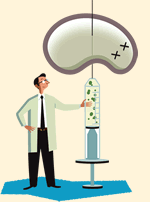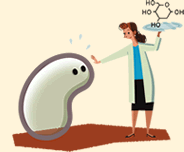|
Academic and research programs battling cancer New Meaning to Cancer Doctor “We’re going to combine both basic and clinical/translational research,” explains David Helfman, Ph.D., director of the new program. “So we have two-tier mentoring, which is unique. “A clinician thinks somewhat differently about cancer than a research scientist,” continues Helfman, also a professor of cell biology and anatomy. “Hopefully, by interacting closely with clinical oncologists, our program is going to bring to light unmet clinical challenges.” Those needs will steer basic science. “And the interest on the part of the clinicians for this has been extraordinary,” says Helfman. Physicians have been writing to him, volunteering to serve as clinical mentors. Immune to a Killer Now, about 70 new patients will get a chance to try the vaccine. Luis E. Raez, M.D, F.A.C.P., co-chair of the Thoracic Oncology Group at UM/Sylvester, has been awarded a three-year $300,000 Clinical Innovator Award from the Flight Attendant Medical Research Institute, funding which makes two new phase II clinical trials possible. In one, patients who are not eligible for surgery but who respond well to chemotherapy will be treated with the vaccine. “Within four months,” explains Raez, “50 percent of those patients with good outcomes from the chemo would relapse.” The hope is the vaccine will delay or prevent that relapse. The second group will be patients who have had their tumors surgically removed. “That’s a better setting for a vaccination,” says Eckhard R. Podack, M.D., Ph.D., chairman of microbiology and immunology, who devised the vaccine. “When there is minimal or no detectable disease, the immune system responds much better.” Feed a Cold, Starve a Tumor
Since 2-DG is a synthetic sugar, it has almost no side effects. Also, it’s oral therapy—a simple drink. And there is evidence from the lab that it might work without chemo. Explains Lampidis: “We’re looking at the use of this false sugar as a relatively non-toxic single agent treatment in certain tumor types, without more toxic chemotherapy.” –Kelly Kaufhold |
 The
new degree program is designed to complement the new National
Institutes of Health Roadmap, geared to take the most promising
findings of basic science and quickly turn them into lifesaving
treatments for patients. That requires a marriage of sorts
between laboratory scientists and physicians seeing patients.
The
new degree program is designed to complement the new National
Institutes of Health Roadmap, geared to take the most promising
findings of basic science and quickly turn them into lifesaving
treatments for patients. That requires a marriage of sorts
between laboratory scientists and physicians seeing patients. A
phase I clinical trial, combining 2-DG with Taxotere, is almost
complete. Twenty-four patients were enrolled, with breast,
lung, head and neck, bladder and gallbladder cancers, and with
tumors of unknown origin. “We have several patients that
have achieved stable disease,” said Luis Raez, M.D.,
F.A.C.P., a UM/Sylvester medical oncologist.
A
phase I clinical trial, combining 2-DG with Taxotere, is almost
complete. Twenty-four patients were enrolled, with breast,
lung, head and neck, bladder and gallbladder cancers, and with
tumors of unknown origin. “We have several patients that
have achieved stable disease,” said Luis Raez, M.D.,
F.A.C.P., a UM/Sylvester medical oncologist.